Deck 22: Scheduling
Question
Question
Question
Question
Question
Question
Question
Question
Question
Question
Question
Question
Question
Question
Question
Question
Question
Question
Question
Question
Question
Question
Question
Question
Question
Question
Question
Question
Question
Question
Question
Question
Question
Question
Question
Question
Question
Question
Question
Question
Question
Question
Question
Question
Question
Question
Question
Question
Question
Question
Question
Question
Question
Question
Question
Question
Question
Question
Question
Question
Question
Question
Question
Question
Question
Question
Question
Question
Question
Question
Question
Question
Question
Question
Question
Question
Question
Question
Question
Question

Unlock Deck
Sign up to unlock the cards in this deck!
Unlock Deck
Unlock Deck
1/98
Play
Full screen (f)
Deck 22: Scheduling
1
The output of the system cannot exceed the output of the bottleneck operation(s).
True
2
Splitting a large lot after one operation beyond a bottleneck operation would reduce the overall waiting time of the bottleneck operation.
False
3
A Gantt chart is a basic scheduling tool that is most useful in low-volume systems.
True
4
Scheduling in intermediate-volume systems has three basic issues: run size, timing, and sequence.

Unlock Deck
Unlock for access to all 98 flashcards in this deck.
Unlock Deck
k this deck
5
The term loading, as used in scheduling, refers to choosing the order in which jobs will be processed in low-volume systems.

Unlock Deck
Unlock for access to all 98 flashcards in this deck.
Unlock Deck
k this deck
6
The elimination of idle time on both bottleneck and non-bottleneck operations must be accomplished to optimize output.

Unlock Deck
Unlock for access to all 98 flashcards in this deck.
Unlock Deck
k this deck
7
Sequencing is concerned with the order in which jobs are done, while loading is concerned with assigning jobs to work centers or workstations.

Unlock Deck
Unlock for access to all 98 flashcards in this deck.
Unlock Deck
k this deck
8
The assignment model seeks an optimum matching of tasks and resources.

Unlock Deck
Unlock for access to all 98 flashcards in this deck.
Unlock Deck
k this deck
9
When orders exceed our capacity, priority rules are used to select which orders will be accepted.

Unlock Deck
Unlock for access to all 98 flashcards in this deck.
Unlock Deck
k this deck
10
Line balancing is a major factor in the design and scheduling of low-volume systems because of batch processing.

Unlock Deck
Unlock for access to all 98 flashcards in this deck.
Unlock Deck
k this deck
11
Flow-shop scheduling is used in high-volume systems.

Unlock Deck
Unlock for access to all 98 flashcards in this deck.
Unlock Deck
k this deck
12
Infinite loading and finite loading are two major approaches used to load work centers.

Unlock Deck
Unlock for access to all 98 flashcards in this deck.
Unlock Deck
k this deck
13
A schedule chart can be used to monitor job progress.

Unlock Deck
Unlock for access to all 98 flashcards in this deck.
Unlock Deck
k this deck
14
Loading is the determination of which work centers should perform which jobs.

Unlock Deck
Unlock for access to all 98 flashcards in this deck.
Unlock Deck
k this deck
15
A Gantt chart is a basic scheduling tool that works best for high-volume systems.

Unlock Deck
Unlock for access to all 98 flashcards in this deck.
Unlock Deck
k this deck
16
When operations are often bottlenecked, additional planned idle time will improve the throughput in those areas.

Unlock Deck
Unlock for access to all 98 flashcards in this deck.
Unlock Deck
k this deck
17
The quantity sent to a bottleneck operation could be split into two or more process batches to better utilize a bottleneck resource rather than process the entire batch.

Unlock Deck
Unlock for access to all 98 flashcards in this deck.
Unlock Deck
k this deck
18
A schedule chart depicts the loading and idle times for a group of machines or departments.

Unlock Deck
Unlock for access to all 98 flashcards in this deck.
Unlock Deck
k this deck
19
As long as the bottleneck operations are used effectively, idle time in non-bottleneck operations will not affect the overall productivity of the system.

Unlock Deck
Unlock for access to all 98 flashcards in this deck.
Unlock Deck
k this deck
20
Input/output (I/O) control refers to monitoring the productivity changes since productivity is determined by the ratio of output to input.

Unlock Deck
Unlock for access to all 98 flashcards in this deck.
Unlock Deck
k this deck
21
Similar to that in manufacturing, the service scheduling hierarchy begins with __________ and ends with _________.
A) aggregate planning; detailed daily scheduling
B) aggregate planning; master scheduling
C) master scheduling; detailed material planning
D) aggregate planning; detailed material planning
E) quarterly planning; monthly planning
A) aggregate planning; detailed daily scheduling
B) aggregate planning; master scheduling
C) master scheduling; detailed material planning
D) aggregate planning; detailed material planning
E) quarterly planning; monthly planning

Unlock Deck
Unlock for access to all 98 flashcards in this deck.
Unlock Deck
k this deck
22
To facilitate utilization of bottleneck operations, in theory of constraints scheduling ________ can be split into __________ to reduce waiting times.
A) bottleneck lots; nonbottleneck lots
B) transfer batches; process lots
C) sized lots; constrained lots
D) process batches; transfer batches
E) buffer lots; transfer lots
A) bottleneck lots; nonbottleneck lots
B) transfer batches; process lots
C) sized lots; constrained lots
D) process batches; transfer batches
E) buffer lots; transfer lots

Unlock Deck
Unlock for access to all 98 flashcards in this deck.
Unlock Deck
k this deck
23
In the decision-making hierarchy, scheduling decisions are the final step in the transformation process before actual output occurs.

Unlock Deck
Unlock for access to all 98 flashcards in this deck.
Unlock Deck
k this deck
24
The theory of constraints has a goal of maximizing flow through the entire system.

Unlock Deck
Unlock for access to all 98 flashcards in this deck.
Unlock Deck
k this deck
25
Priority rules are widely used to sequence jobs in high-volume systems.

Unlock Deck
Unlock for access to all 98 flashcards in this deck.
Unlock Deck
k this deck
26
In theory of constraints scheduling, the synchronization of the sequence of operations is referred to as the:
A) buffer.
B) bottleneck.
C) constraint.
D) ropE.
E) drum.
A) buffer.
B) bottleneck.
C) constraint.
D) ropE.
E) drum.

Unlock Deck
Unlock for access to all 98 flashcards in this deck.
Unlock Deck
k this deck
27
Ensuring that the constraining resource is used to its maximum is an example of constraint:
A) elevation.
B) subordination.
C) identification.
D) elimination.
E) exploitation.
A) elevation.
B) subordination.
C) identification.
D) elimination.
E) exploitation.

Unlock Deck
Unlock for access to all 98 flashcards in this deck.
Unlock Deck
k this deck
28
Makespan is the total time needed to complete a group of jobs.

Unlock Deck
Unlock for access to all 98 flashcards in this deck.
Unlock Deck
k this deck
29
The SPT priority rule always results in the lowest average completion time.

Unlock Deck
Unlock for access to all 98 flashcards in this deck.
Unlock Deck
k this deck
30
Priority rules are used in low-volume systems to identify an optimal processing sequence.

Unlock Deck
Unlock for access to all 98 flashcards in this deck.
Unlock Deck
k this deck
31
The Hungarian method is limited to a maximum of two jobs per resource.

Unlock Deck
Unlock for access to all 98 flashcards in this deck.
Unlock Deck
k this deck
32
In theory of constraints scheduling, the __________ refers to the schedule and the __________ refers to inventory used to ensure that the bottleneck is never idle.
A) rope; drum
B) drum; rope
C) drum; buffer
D) buffer; drum
E) buffer; rope
A) rope; drum
B) drum; rope
C) drum; buffer
D) buffer; drum
E) buffer; rope

Unlock Deck
Unlock for access to all 98 flashcards in this deck.
Unlock Deck
k this deck
33
Scheduling pertains to:
A) hiring workers.
B) process selection.
C) buying machinery.
D) timing the use of specific resources.
E) determining the lowest cost.
A) hiring workers.
B) process selection.
C) buying machinery.
D) timing the use of specific resources.
E) determining the lowest cost.

Unlock Deck
Unlock for access to all 98 flashcards in this deck.
Unlock Deck
k this deck
34
In a single work center, makespan improvement can be accomplished by selecting the optimal sequencing rule.

Unlock Deck
Unlock for access to all 98 flashcards in this deck.
Unlock Deck
k this deck
35
Which of the following is not usually a characteristic of successful high-volume systems?
A) smooth workflow through the system
B) customized output
C) rapid repair of breakdowns
D) minimal quality problems
E) reliable supply schedules
A) smooth workflow through the system
B) customized output
C) rapid repair of breakdowns
D) minimal quality problems
E) reliable supply schedules

Unlock Deck
Unlock for access to all 98 flashcards in this deck.
Unlock Deck
k this deck
36
Which of the following is the last step in the capacity/scheduling chain?
A) product planning
B) process planning
C) capacity planning
D) aggregate planning
E) scheduling
A) product planning
B) process planning
C) capacity planning
D) aggregate planning
E) scheduling

Unlock Deck
Unlock for access to all 98 flashcards in this deck.
Unlock Deck
k this deck
37
Priority rules generally assume that job setup cost is independent of the processing sequence of jobs.

Unlock Deck
Unlock for access to all 98 flashcards in this deck.
Unlock Deck
k this deck
38
Which of the following is present in the manufacturing scheduling hierarchy but is absent in the service scheduling hierarchy?
A) aggregate planning
B) materials planning
C) master scheduling
D) detailed, short-term scheduling
E) detailed, short-term planning
A) aggregate planning
B) materials planning
C) master scheduling
D) detailed, short-term scheduling
E) detailed, short-term planning

Unlock Deck
Unlock for access to all 98 flashcards in this deck.
Unlock Deck
k this deck
39
Which of the following is not an example of a high-volume system?
A) aircraft manufacturing
B) magazine printing
C) petroleum refining
D) waste treatment
E) commercial donut baking
A) aircraft manufacturing
B) magazine printing
C) petroleum refining
D) waste treatment
E) commercial donut baking

Unlock Deck
Unlock for access to all 98 flashcards in this deck.
Unlock Deck
k this deck
40
Bottlenecks in service systems may shift with the passage of time, so that different operations become bottleneck operations at different times.

Unlock Deck
Unlock for access to all 98 flashcards in this deck.
Unlock Deck
k this deck
41
The following matrix shows relative costs for various job-machine combinations. Assume there must be one-to-one matching between jobs and machines. Which set of pairs constitutes the minimum-cost solution using the assignment method? 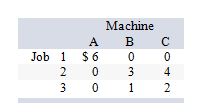
A) 1-B, 2-C, 3-A
B) 1-B, 2-A, 3-C
C) 1-A, 2-C, 3-B
D) 1-A, 2-B, 3-C
E) 1-C, 2-A, 3-B

A) 1-B, 2-C, 3-A
B) 1-B, 2-A, 3-C
C) 1-A, 2-C, 3-B
D) 1-A, 2-B, 3-C
E) 1-C, 2-A, 3-B

Unlock Deck
Unlock for access to all 98 flashcards in this deck.
Unlock Deck
k this deck
42
Primary considerations in scheduling high-volume systems involve:
A) I and III
B) I and II
C) II and III
D) I, II, and III
E) II only
A) I and III
B) I and II
C) II and III
D) I, II, and III
E) II only

Unlock Deck
Unlock for access to all 98 flashcards in this deck.
Unlock Deck
k this deck
43
Effective scheduling cannot:
A) yield cost savings and improved productivity.
B) reduce the need for expansion of facilities.
C) improve customer service.
D) eliminate the need to train employees.
E) improve patient care in medical settings.
A) yield cost savings and improved productivity.
B) reduce the need for expansion of facilities.
C) improve customer service.
D) eliminate the need to train employees.
E) improve patient care in medical settings.

Unlock Deck
Unlock for access to all 98 flashcards in this deck.
Unlock Deck
k this deck
44
Which of the following is not an assumption of priority rules?
A) The set of jobs is known: no new jobs arrive after processing begins.
B) Setup time is independent of processing sequence.
C) Finite loading is assumeD.
D) Processing times are deterministic.
E) No machine breakdowns are assumed.
A) The set of jobs is known: no new jobs arrive after processing begins.
B) Setup time is independent of processing sequence.
C) Finite loading is assumeD.
D) Processing times are deterministic.
E) No machine breakdowns are assumed.

Unlock Deck
Unlock for access to all 98 flashcards in this deck.
Unlock Deck
k this deck
45
Average completion (flow) time for a schedule sequence at a work center is:
A) the sum of processing time divided by the number of jobs.
B) the sum of jobs' flow times divided by the number of jobs.
C) overall flow time divided by total processing time.
D) total processing time plus total late time divided by number of jobs.
E) the sum of flow time plus total late time divided by number of jobs.
A) the sum of processing time divided by the number of jobs.
B) the sum of jobs' flow times divided by the number of jobs.
C) overall flow time divided by total processing time.
D) total processing time plus total late time divided by number of jobs.
E) the sum of flow time plus total late time divided by number of jobs.

Unlock Deck
Unlock for access to all 98 flashcards in this deck.
Unlock Deck
k this deck
46
Scheduled due dates are the result of:
A) promises to customers.
B) MRP processing.
C) managerial decisions.
D) all of the choices.
E) our competitor's promises.
A) promises to customers.
B) MRP processing.
C) managerial decisions.
D) all of the choices.
E) our competitor's promises.

Unlock Deck
Unlock for access to all 98 flashcards in this deck.
Unlock Deck
k this deck
47
Which sequencing rule is designed specifically to minimize job tardiness?
A) S/O
B) EDD
C) FCFS
D) SPT
E) LPT
A) S/O
B) EDD
C) FCFS
D) SPT
E) LPT

Unlock Deck
Unlock for access to all 98 flashcards in this deck.
Unlock Deck
k this deck
48
Organizations with fixed, perishable capacity can benefit from:
A) yield management.
B) price increases.
C) constraints.
D) suboptimization.
E) waiting lines.
A) yield management.
B) price increases.
C) constraints.
D) suboptimization.
E) waiting lines.

Unlock Deck
Unlock for access to all 98 flashcards in this deck.
Unlock Deck
k this deck
49
Based on the cost information given in the following table, which set of job-machine pairs reflects the minimum-cost solution using the Assignment method? 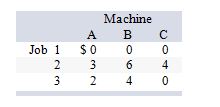
A) 1-B, 2-A, 3-C
B) 1-A, 2-B, 3-C
C) 1-C, 2-A, 3-B
D) 1-B, 2-C, 3-A
E) 1-C, 2-B, 3-A

A) 1-B, 2-A, 3-C
B) 1-A, 2-B, 3-C
C) 1-C, 2-A, 3-B
D) 1-B, 2-C, 3-A
E) 1-C, 2-B, 3-A

Unlock Deck
Unlock for access to all 98 flashcards in this deck.
Unlock Deck
k this deck
50
The two different approaches to load work centers in job-shop scheduling are:
A) load charts and schedule charts.
B) Gantt charts and assignment method.
C) infinite loading and finite loading.
D) linear programming and makespan.
E) infinite charting and finite charting.
A) load charts and schedule charts.
B) Gantt charts and assignment method.
C) infinite loading and finite loading.
D) linear programming and makespan.
E) infinite charting and finite charting.

Unlock Deck
Unlock for access to all 98 flashcards in this deck.
Unlock Deck
k this deck
51
The scheduling sequencing rule which always results in the lowest average completion (flow) time is the:
A) first come, first served (FCFS) rule.
B) shortest processing time first (SPT) rulE.
C) earliest due date first (EDD) rule.
D) least slack per operation first (S/O) rule.
E) run until slack happens (RUSH) rule.
A) first come, first served (FCFS) rule.
B) shortest processing time first (SPT) rulE.
C) earliest due date first (EDD) rule.
D) least slack per operation first (S/O) rule.
E) run until slack happens (RUSH) rule.

Unlock Deck
Unlock for access to all 98 flashcards in this deck.
Unlock Deck
k this deck
52
A scheduling rule used for sequencing jobs through two work centers such that makespan is minimized is:
A) critical ratio rule.
B) Johnson's rulE.
C) slack per operation rule.
D) shortest processing time rule.
E) Pareto rule.
A) critical ratio rule.
B) Johnson's rulE.
C) slack per operation rule.
D) shortest processing time rule.
E) Pareto rule.

Unlock Deck
Unlock for access to all 98 flashcards in this deck.
Unlock Deck
k this deck
53
A scheduling technique used to achieve an optimum matching of tasks and resources is:
A) the assignment methoD.
B) Johnson's rule.
C) the optimum production technology method.
D) the appointment method.
E) the reservation method.
A) the assignment methoD.
B) Johnson's rule.
C) the optimum production technology method.
D) the appointment method.
E) the reservation method.

Unlock Deck
Unlock for access to all 98 flashcards in this deck.
Unlock Deck
k this deck
54
Which of the following is not a measure for judging the effectiveness of a schedule sequence?
A) average number of jobs at the work center
B) total number of jobs at the work center
C) average completion (flow) time
D) average job tardiness
E) length of time between start of first job to completion of the last job in the work center
A) average number of jobs at the work center
B) total number of jobs at the work center
C) average completion (flow) time
D) average job tardiness
E) length of time between start of first job to completion of the last job in the work center

Unlock Deck
Unlock for access to all 98 flashcards in this deck.
Unlock Deck
k this deck
55
The priority rule where jobs are processed according to the smallest ratio of time remaining to due date to processing time is:
A) CR.
B) EEDD.
C) FCFS.
D) S/O.
E) SPT.
A) CR.
B) EEDD.
C) FCFS.
D) S/O.
E) SPT.

Unlock Deck
Unlock for access to all 98 flashcards in this deck.
Unlock Deck
k this deck
56
The priority rule which will sequence jobs in the order they are received is:
A) EDD.
B) LIFO.
C) SPT.
D) CR.
E) FCFS.
A) EDD.
B) LIFO.
C) SPT.
D) CR.
E) FCFS.

Unlock Deck
Unlock for access to all 98 flashcards in this deck.
Unlock Deck
k this deck
57
The EDD priority rule usually does well with regard to:
A) cost.
B) lateness.
C) overtime.
D) waste.
E) makespan.
A) cost.
B) lateness.
C) overtime.
D) waste.
E) makespan.

Unlock Deck
Unlock for access to all 98 flashcards in this deck.
Unlock Deck
k this deck
58
A work center can be a:
(I) machine.
(II) group of machines.
(III) department.
IV) a part used to produce a product.
A) I, II, and III only
B) II and IV only
C) II and III only
D) I and III only
E) I, II, III, and IV
(I) machine.
(II) group of machines.
(III) department.
IV) a part used to produce a product.
A) I, II, and III only
B) II and IV only
C) II and III only
D) I and III only
E) I, II, III, and IV

Unlock Deck
Unlock for access to all 98 flashcards in this deck.
Unlock Deck
k this deck
59
The purpose of cyclical scheduling is to:
A) eliminate weekends and holidays.
B) establish work assignments that will repeat on a cyclical basis.
C) add flexible hours.
D) incorporate overtime.
E) rotate schedules across a service workforce to ensure everyone gets an equal number of weekends off per year.
A) eliminate weekends and holidays.
B) establish work assignments that will repeat on a cyclical basis.
C) add flexible hours.
D) incorporate overtime.
E) rotate schedules across a service workforce to ensure everyone gets an equal number of weekends off per year.

Unlock Deck
Unlock for access to all 98 flashcards in this deck.
Unlock Deck
k this deck
60
In a task assignment situation, in how many different ways can five jobs be assigned to five machines if each job must be assigned to each machine and each machine must be assigned one job?
A) 1
B) 5
C) 25
D) 120
E) 3,125
A) 1
B) 5
C) 25
D) 120
E) 3,125

Unlock Deck
Unlock for access to all 98 flashcards in this deck.
Unlock Deck
k this deck
61
One disadvantage of appointment systems is:
A) Capacity can be adjusted by varying hours.
B) The customer's desired time may be already taken.
C) People generally accept it as fair.
D) It can reduce customer waiting time.
E) Appointments do not have to be all the same length.
A) Capacity can be adjusted by varying hours.
B) The customer's desired time may be already taken.
C) People generally accept it as fair.
D) It can reduce customer waiting time.
E) Appointments do not have to be all the same length.

Unlock Deck
Unlock for access to all 98 flashcards in this deck.
Unlock Deck
k this deck
62
There are four resources and four jobs to be done. Assume there must be one-to-one matching between jobs and resources. The time required for each resource to do each job is as follows: 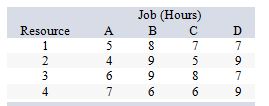
After the row reduction, what is the resulting entry in the new table for assigning resource 4 to Job D?
A) 0 hours
B) 2 hours
C) 3 hours
D) 6 hours
E) 9 hours

After the row reduction, what is the resulting entry in the new table for assigning resource 4 to Job D?
A) 0 hours
B) 2 hours
C) 3 hours
D) 6 hours
E) 9 hours

Unlock Deck
Unlock for access to all 98 flashcards in this deck.
Unlock Deck
k this deck
63
The owner/operator of the local franchise of Handyman, Inc., has four jobs to do today, shown in the order they were received: 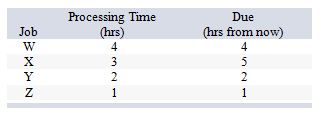
If he uses the earliest due date first priority rule to schedule these jobs, what will be the average job tardiness?
A) 0 hours
B) 1.5 hours
C) 1.75 hours
D) 2 hours
E) 2.25 hours

If he uses the earliest due date first priority rule to schedule these jobs, what will be the average job tardiness?
A) 0 hours
B) 1.5 hours
C) 1.75 hours
D) 2 hours
E) 2.25 hours

Unlock Deck
Unlock for access to all 98 flashcards in this deck.
Unlock Deck
k this deck
64
What is the optimum job sequence for the jobs listed below using Johnson's rule? 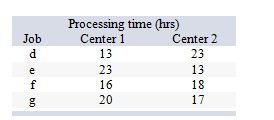
A) e-g-f-d
B) d-g-f-e
C) d-f-g-e
D) e-d-f-g
E) f-e-d-g

A) e-g-f-d
B) d-g-f-e
C) d-f-g-e
D) e-d-f-g
E) f-e-d-g

Unlock Deck
Unlock for access to all 98 flashcards in this deck.
Unlock Deck
k this deck
65
Scheduling in service systems often takes the form of:
(I) appointment systems.
(II) reservation systems.
(III) makespan systems.
A) I only
B) II only
C) I and II only
D) III only
E) I, II, and III
(I) appointment systems.
(II) reservation systems.
(III) makespan systems.
A) I only
B) II only
C) I and II only
D) III only
E) I, II, and III

Unlock Deck
Unlock for access to all 98 flashcards in this deck.
Unlock Deck
k this deck
66
The president of a consulting firm wants to minimize the total number of hours it will take to complete four projects for a new client. Accordingly, she has estimated the time it should take for each of her top consultants-Charlie, Betty, Johnny, and Rick-to complete any of the four projects, as follows: 
Assume there must be one-to-one matching between consultants and projects. In how many different ways can she assign these consultants to these projects?
A) 4
B) 8
C) 16
D) 24
E) 256

Assume there must be one-to-one matching between consultants and projects. In how many different ways can she assign these consultants to these projects?
A) 4
B) 8
C) 16
D) 24
E) 256

Unlock Deck
Unlock for access to all 98 flashcards in this deck.
Unlock Deck
k this deck
67
In an assignment model where there are fewer jobs than resources:
A) dummy jobs are needed to solve the problem.
B) dummy resources are needed to solve the problem.
C) the problem cannot be solved using an assignment model.
D) the problem will have multiple optimum solutions.
E) the simplex method must be used to solve the problem.
A) dummy jobs are needed to solve the problem.
B) dummy resources are needed to solve the problem.
C) the problem cannot be solved using an assignment model.
D) the problem will have multiple optimum solutions.
E) the simplex method must be used to solve the problem.

Unlock Deck
Unlock for access to all 98 flashcards in this deck.
Unlock Deck
k this deck
68
The following table contains information about five jobs waiting to be processed at work center number three. 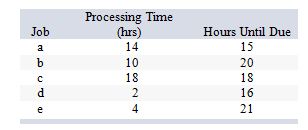
The sequence that would result using the SPT rule is:
A) e-b-c-d-a.
B) c-a-b-e-d.
C) a-d-c-e-b.
D) d-e-b-a-C.
E) e-d-b-a-c.

The sequence that would result using the SPT rule is:
A) e-b-c-d-a.
B) c-a-b-e-d.
C) a-d-c-e-b.
D) d-e-b-a-C.
E) e-d-b-a-c.

Unlock Deck
Unlock for access to all 98 flashcards in this deck.
Unlock Deck
k this deck
69
There are four resources and four jobs to be done. Assume there must be one-to-one matching between jobs and resources. The time required for each resource to do each job is as follows: 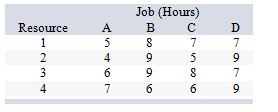
For the optimal schedule, what is the total number of hours required to complete these jobs?
A) 23 hours
B) 22 hours
C) 21 hours
D) 20 hours
E) 19 hours

For the optimal schedule, what is the total number of hours required to complete these jobs?
A) 23 hours
B) 22 hours
C) 21 hours
D) 20 hours
E) 19 hours

Unlock Deck
Unlock for access to all 98 flashcards in this deck.
Unlock Deck
k this deck
70
The president of a consulting firm wants to minimize the total number of hours it will take to complete four projects for a new client. Accordingly, she has estimated the time it should take for each of her top consultants-Charlie, Betty, Johnny, and Rick-to complete any of the four projects, as follows: 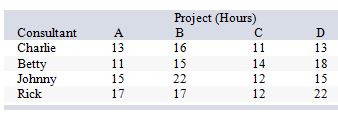
Assume there must be one-to-one matching between consultants and projects. After the row and column reductions, what is the resulting entry in the new table for assigning Rick to project D?
A) 0 hours
B) 8 hours
C) 10 hours
D) 9 hours
E) 22 hours

Assume there must be one-to-one matching between consultants and projects. After the row and column reductions, what is the resulting entry in the new table for assigning Rick to project D?
A) 0 hours
B) 8 hours
C) 10 hours
D) 9 hours
E) 22 hours

Unlock Deck
Unlock for access to all 98 flashcards in this deck.
Unlock Deck
k this deck
71
There are four resources and four jobs to be done. Assume there must be one-to-one matching between jobs and resources. The time required for each resource to do each job is as follows: 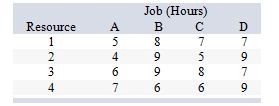
After the row and column reductions, what is the resulting entry in the new table for assigning resource 4 to job D?
A) 0 hours
B) 2 hours
C) 3 hours
D) 6 hours
E) 9 hours

After the row and column reductions, what is the resulting entry in the new table for assigning resource 4 to job D?
A) 0 hours
B) 2 hours
C) 3 hours
D) 6 hours
E) 9 hours

Unlock Deck
Unlock for access to all 98 flashcards in this deck.
Unlock Deck
k this deck
72
A major difference between manufacturing and service systems in terms of scheduling is:
A) variability in arrival and service rates.
B) processing cost per unit.
C) the number of units to be processed.
D) length of processing time.
E) output rate.
A) variability in arrival and service rates.
B) processing cost per unit.
C) the number of units to be processed.
D) length of processing time.
E) output rate.

Unlock Deck
Unlock for access to all 98 flashcards in this deck.
Unlock Deck
k this deck
73
For the jobs listed below, which processing sequence would result using Johnson's rule? 
A) c-a-d-b
B) b-d-a-c
C) a-b-c-d
D) d-c-b-a
E) c-a-b-d

A) c-a-d-b
B) b-d-a-c
C) a-b-c-d
D) d-c-b-a
E) c-a-b-d

Unlock Deck
Unlock for access to all 98 flashcards in this deck.
Unlock Deck
k this deck
74
The following table contains information about five jobs waiting to be processed at work center number three. 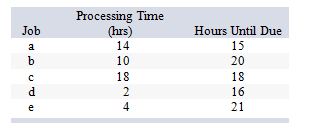
Using the EDD rule, the sequence of jobs would be:
A) d-e-b-a-c.
B) a-d-c-b-E.
C) e-d-b-a-c.
D) a-d-c-e-d.
E) e-b-c-d-a.

Using the EDD rule, the sequence of jobs would be:
A) d-e-b-a-c.
B) a-d-c-b-E.
C) e-d-b-a-c.
D) a-d-c-e-d.
E) e-b-c-d-a.

Unlock Deck
Unlock for access to all 98 flashcards in this deck.
Unlock Deck
k this deck
75
The president of a consulting firm wants to minimize the total number of hours it will take to complete four projects for a new client. Accordingly, she has estimated the time it should take for each of her top consultants-Charlie, Betty, Johnny, and Rick-to complete any of the four projects, as follows: 
Assume there must be one-to-one matching between consultants and projects. What is the optimal assignment of consultants to projects?
A) Charlie to A; Betty to B; Johnny to C; Rick to D
B) Charlie to D; Betty to C; Johnny to B; Rick to A
C) Charlie to C; Betty to A; Johnny to D; Rick to B
D) Charlie to D; Betty to B; Johnny to C; Rick to A
E) Charlie to D; Betty to A; Johnny to C; Rick to B

Assume there must be one-to-one matching between consultants and projects. What is the optimal assignment of consultants to projects?
A) Charlie to A; Betty to B; Johnny to C; Rick to D
B) Charlie to D; Betty to C; Johnny to B; Rick to A
C) Charlie to C; Betty to A; Johnny to D; Rick to B
D) Charlie to D; Betty to B; Johnny to C; Rick to A
E) Charlie to D; Betty to A; Johnny to C; Rick to B

Unlock Deck
Unlock for access to all 98 flashcards in this deck.
Unlock Deck
k this deck
76
There are four resources and four jobs to be done. Assume there must be one-to-one matching between jobs and resources. The time required for each resource to do each job is as follows: 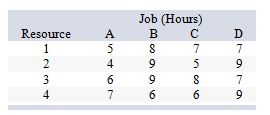
After the row and column reductions, what is the minimum number of lines needed to cover all of the zeroes?
A) 0 lines
B) 1 line
C) 2 lines
D) 3 lines
E) 4 lines

After the row and column reductions, what is the minimum number of lines needed to cover all of the zeroes?
A) 0 lines
B) 1 line
C) 2 lines
D) 3 lines
E) 4 lines

Unlock Deck
Unlock for access to all 98 flashcards in this deck.
Unlock Deck
k this deck
77
There are four resources and four jobs to be done. Assume there must be one-to-one matching between jobs and resources. The time required for each resource to do each job is as follows: 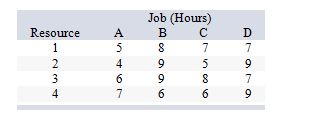
What is the optimal assignment of resources to jobs?
A) 1 to A; 2 to C; 3 to B; 4 to D
B) 1 to B; 2 to D; 3 to C; 4 to A
C) 1 to C; 2 to B; 3 to A; 4 to D
D) 1 to D; 2 to B; 3 to C; 4 to A
E) 1 to A; 2 to C; 3 to D; 4 to B

What is the optimal assignment of resources to jobs?
A) 1 to A; 2 to C; 3 to B; 4 to D
B) 1 to B; 2 to D; 3 to C; 4 to A
C) 1 to C; 2 to B; 3 to A; 4 to D
D) 1 to D; 2 to B; 3 to C; 4 to A
E) 1 to A; 2 to C; 3 to D; 4 to B

Unlock Deck
Unlock for access to all 98 flashcards in this deck.
Unlock Deck
k this deck
78
The owner/operator of the local franchise of Handyman, Inc., has four jobs to do today, shown in the order they were received: 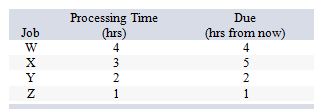
If he uses the first come, first served priority rule to schedule these jobs, what will be the average completion time?
A) 7.5 hours
B) 5 hours
C) 3 hours
D) 2.5 hours
E) 2 hours

If he uses the first come, first served priority rule to schedule these jobs, what will be the average completion time?
A) 7.5 hours
B) 5 hours
C) 3 hours
D) 2.5 hours
E) 2 hours

Unlock Deck
Unlock for access to all 98 flashcards in this deck.
Unlock Deck
k this deck
79
The president of a consulting firm wants to minimize the total number of hours it will take to complete four projects for a new client. Accordingly, she has estimated the time it should take for each of her top consultants-Charlie, Betty, Johnny, and Rick-to complete any of the four projects, as follows: 
Assume there must be one-to-one matching between consultants and projects. For the optimal schedule, what is the total number of hours it will take these consultants to complete these projects?
A) 53 hours
B) 46 hours
C) 50 hours
D) 61 hours
E) 54 hours

Assume there must be one-to-one matching between consultants and projects. For the optimal schedule, what is the total number of hours it will take these consultants to complete these projects?
A) 53 hours
B) 46 hours
C) 50 hours
D) 61 hours
E) 54 hours

Unlock Deck
Unlock for access to all 98 flashcards in this deck.
Unlock Deck
k this deck
80
Scheduling in service systems may involve scheduling:
(I) the workforce.
(II) the equipment.
(III) customers.
A) II only
B) I and II only
C) II and III only
D) I and III only
E) I, II, and III
(I) the workforce.
(II) the equipment.
(III) customers.
A) II only
B) I and II only
C) II and III only
D) I and III only
E) I, II, and III

Unlock Deck
Unlock for access to all 98 flashcards in this deck.
Unlock Deck
k this deck



